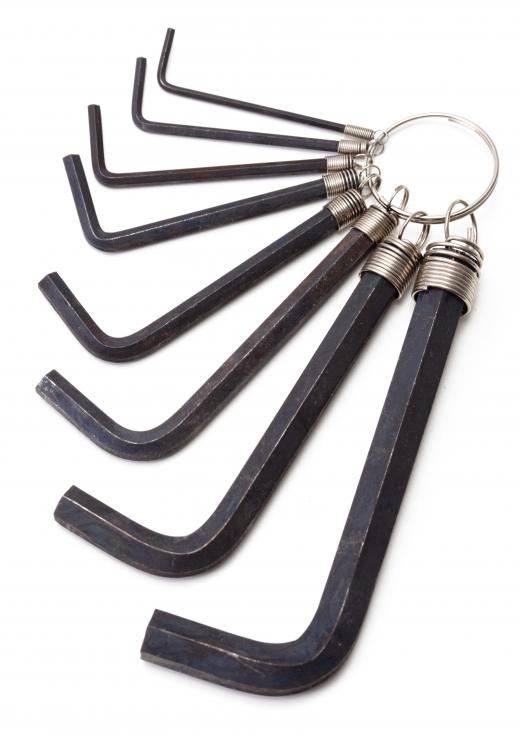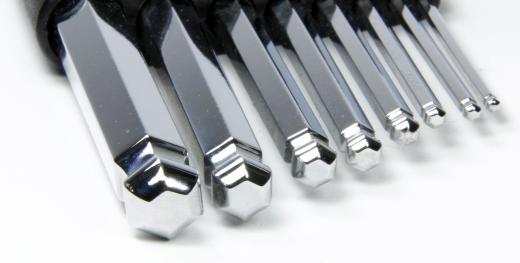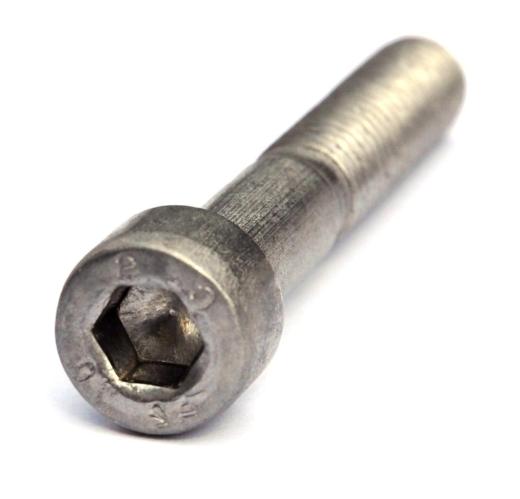An Allen wrench is a small, angled tool with a hexagonal head that’s commonly used to repair or tighten a number of small appliances or parts. It’s also known as either a hex key or a hex wrench. The tool comes in varying sizes designed to correspond to differently sized joints or screw holds. It typically only works with hexagonal screws or bolts, but these are more common than many people think. Most bicycles use these sorts of joints, for instance, as do many motorcycle and boat engines; they’re also standard on most in-sink garbage disposals. Some do-it-yourself or build-at-home furniture also uses hexagonal screws. This sort of wrench comes in many home tool kits, and is also readily available in hardware stores in most places. They tend to be quite small, though, and as such are often misplaced; many professionals recommend keeping them tethered or stored in a contained place to keep from losing them.
Basic Concept

This tool is usually defined by the hexagonal, or six-sided, cross section that fits screw heads with similarly six-sided recesses. The tool is unique in that it fits into a receptacle to turn it rather than around a screw or bolt like a regular wrench. This makes it the only tool that can access fasteners that have no protruding heads and are flush with the object being assembled or repaired. The surfaces of the screws and bolts are protected from damage because they are recessed. With this tool, things like motorcycle engine covers can be easily mounted flush to the engine case without the heads of the bolts sticking out. Similarly, furniture joints can be screwed in beneath the outer surface, which leads to a flat or indented surface rather than one that bumps out.

Other features that make the wrench popular are its small size and light weight. It is also somewhat unique in that it can typically reach very small and buried screws with ease. The ends are usually interchangeable, though torque is limited by the wrench's length and thickness.
Available Sizes
Allen wrenches are typically available in both metric and fractional inch sizes, though some of this depends on location. There are usually a number of different options depending on the project and setting. The three most popular sizes for automotive and motorcycle repair, for instance, are 5/32 inch, 3/16 inch, and 1/4 inch, and in metric sizes, 4 mm, 5 mm, and 6 mm are favored. The international Society of Automobile Engineers (SAE) also makes a few additional recommendations; the group’s “preferred” sizes include 3/32 inch, 7/6 inch, 1/8 inch, 9/64 inch, and 7/32 inch.

The sizes used to assemble furniture vary depending on the piece of furniture, and are usually made with the specific screw in mind. Allen wrenches for furniture assembly are normally included in the box with the product. They are so inexpensive to manufacture that the inclusion doesn’t add much to the distributor’s overhead, and in most cases using six-sided screw joints saves a lot of money on the manufacturing side anyway. Most of these sorts of wrenches are more or less disposable and generally aren’t made of very quality materials. Anyone looking to disassemble furniture made this way who doesn’t have the needed wrench can usually find one that will fit at a hardware store.
Popularity and Traditional Uses
The invention of this wrench is often mistakenly attributed to someone named Allen. History indicates the first tool of this type was developed in the early 20th century by the Standard Pressed Steel Company. The trademark for the design was taken out in 1943 by the Allen Manufacturing Company, which is where the name comes from. In its early days, the wrench was common tool only for those seeking to repair bicycles or motorcycle engines. Today its use has become quite widespread.
Storing the Tool
The most common complaint about these tools is how easily they are misplaced or lost. Since its length is less than half of that of even a socket wrench and its circumference is usually smaller than a standard pen or pencil, it can be inadvertently thrown out with packaging materials or swept up with debris in the garage. The most popular way to keep track of different sizes of Allen wrenches is to keep them separate from other tools in a special container, or to loop or tether them together.
